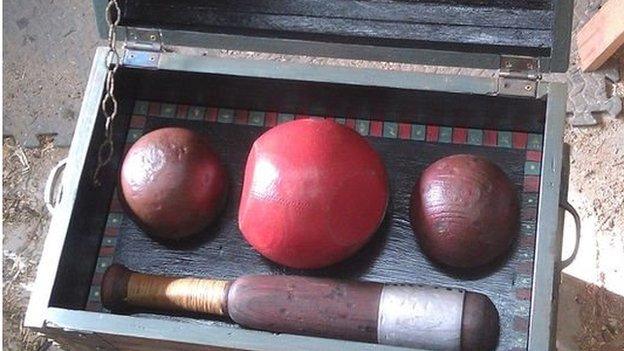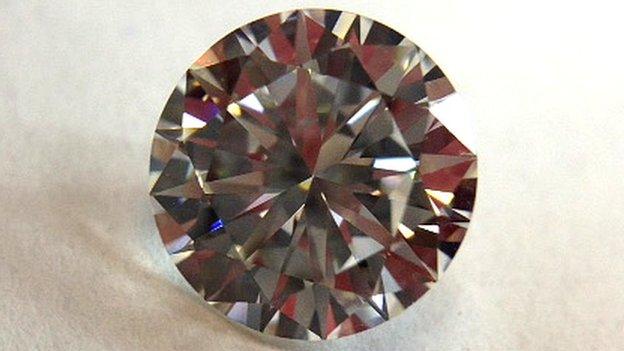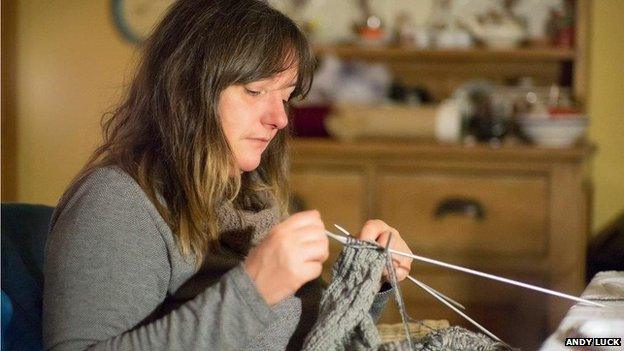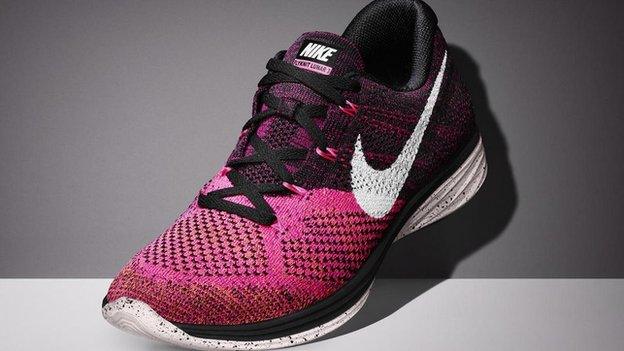The good stuff without the posh label
- Published

Di Gilpin (right) creates couture knitwear in her sheep-scented bothy
"There is hardly anything in the world that some man cannot make a little worse and sell a little cheaper," said Victorian art critic John Ruskin.
At the other end of the spectrum, there are plenty of people making goods a little better, and more expensively.
And most of these goods come with a big, luxury-brand label attached.
Di Gilpin's knitwear doesn't.
The prices are high, although not eye-poppingly so - in the region of £400 ($600, €550) for a sweater.
From her 15th Century bothy [one room stone cottage], near St Andrews in eastern Scotland, she has also created £4,000 knitted couture pieces for the catwalk.
It's anything other than a sleek, commercial machine: "The bothy sometimes smells quite woody or peaty. Its like walking into a woolly, sheepy environment - a nostalgic smell, comforting and inclusive and homey."



She says her creations also have a strong identity: "When you see a piece walking down the street people recognise what it is.
"Hand-knits become you in a sense. As you wear them they take on you as a personality - you might get recognised in the distance for the garment you're wearing."
Finding quality items with individual personality can be tricky as luxury-branded goods become more ubiquitous.
Uche Pezard, founder of luxury goods management consultancy Luxe Corp, illustrates this: "I was in Dubai last week. I could have been in New York or Shanghai - the malls all look the same.
"Homogenisation of the luxury model is good in a way because it keeps consistency. But it becomes tiring - and boring."
Unique
There's little homogeneity about US firm CustomMade.com, a website that claims to connect 12,000 makers with 100,000 buyers.
Customers effectively put their orders out to tender, so typically, these are one-offs.
You tell the site what you want, outline a budget, post an image if it helps, and designers and manufacturers will then offer their suggestions.

A bespoke Quidditch set anyone?
Its range of goods is almost limitless. It even made a Quidditch set for one couple.
CustomMade's president and chief executive, Seth Rosen, says: "There are a lot of companies that connect people to existing products - things that are already made.
"We are unique in that we seek to connect people who want to get something that is not yet made, made."
Shiny
If there's one item that defines consistent luxury - but also individuality - perhaps it is the diamond.
In its pure form, this simple piece of rock doesn't come with a luxury brand label attached. Its appearance - and value - is enhanced by cutting and polishing.

Look closely - there's an £18,000 diamond in there somewhere...
At the SB Jewellery workshop in the UK's jewellery trade centre of Hatton Garden, London, Eddie Taylor is setting a diamond.
The stunningly beautiful stone is worth £18,000.
Part of the point of a diamond is its intrinsic value, he says. But even on a rock, sticking a well-known name on it can dramatically increase its perceived worth.
"If it's a Cartier, or a Tiffany, it will leap in price," he says. "You can easily pay 150% more for a diamond with one of those labelled boxes."
Control
And even without the might of a big brand name, the value of a diamond is not set in stone, so to speak.
Eddie Taylor says that as mining giant De Beers tightly controls the supply of the precious stones, this underpins prices.
"De Beers has six skip loads of diamonds sitting about. Six skip loads. Imagine what that would do to prices if it were suddenly let on to the market. It would kill it."
De Beers' released its diamonds in strictly controlled sales that take place just 10 times a year to specially invited customers. But it says that's not an artificial restriction. It says it only has enough ready to sell to supply two of these sales.

Eddie Taylor's £18,000 stone ready for its close up
Whatever the case, restricting supply is certainly one of the best-used tricks in the book, says Uche Pezard: "A Birkin or Kelly bag by Hermes costs about €10,000 (£7,200, $10,600). But they are simply not regularly stocked and you cannot go on a waiting list. You have to turn up at the shop and hope they have one on that day and you're in time to buy it."
That means, she says, their resale price far outstrips the original retail.
"In the UAE [United Arab Emirates] it is considered a sign of the most serious intent if the man presents one on a first date. To do that, he has to pay €50,000.
"You know why? He doesn't have time to buy one himself, so he has to go to someone who already has one."
Word of mouth
Limiting supply is not a trick open to most smaller craft manufacturers. It is something Di Gilpin's small bothy does well enough in itself.
But getting her name out there is also hampered by its scale - and location. There a limit to the number of people who are going to pop in to browse in rural Fife.
So what do manufacturers do when they don't have the resources of a De Beers, an Hermes, or the other super-luxury brands?

Di Gilpin's stitch craft has hooked some surprising visitors
But being the best can sometimes mean you get hunted out regardless.
CustomMade's Seth Rosen says word gets around: "Our approach has been to take care of our makers, keep the customers happy, and the growth takes care of itself.
"Our product is good enough if you just execute really well every day. That's what makes the difference."
Fishing to feet
When asked about her marketing budget, Di Gilpin laughs. It's so small it barely exists, she says. She will send you a USB stick loaded with films about the work, if you ask.
And that word-of-mouth can bring some impressive connections.
"Sometimes people come to us via quite odd routes," says Ms Gilpin. "Nike came to us looking for an expert in gansey knitting [a type of stitch favoured for fishermen's jumpers].

Some Nike trainers now feature knot stitched fabrics
"It was interested in exploring the concept of knitting to create their running shoes. We discussed why knot [stitch] was better for making those than weaving. The nature of the knot stitch allows the shoe to move with the foot - like a second skin.
"Now, a lot of Nike shoes are knitted rather than woven - and that was through them coming to us."
Read more features in our Life of Luxury series here.